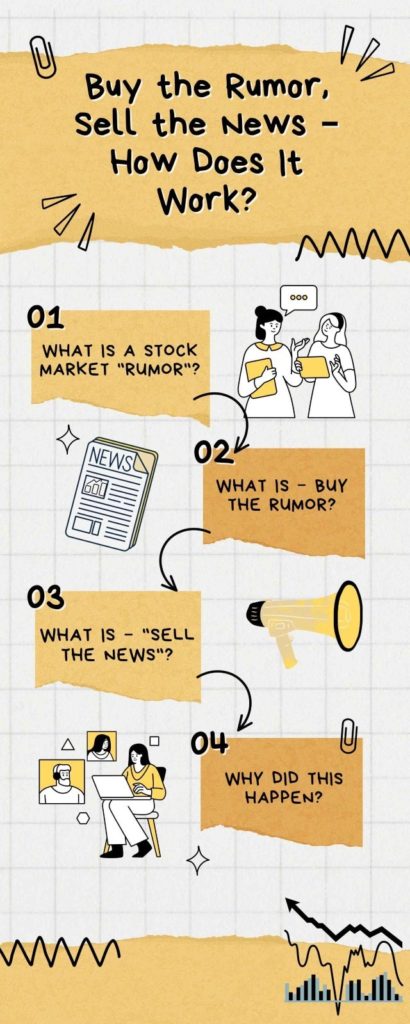Buy the Rumor, Sell the News – How Does It Work?

As per a recent global investing survey, about 39% of Canadians invest in stocks. As per a survey, Canada ranks 6th out of 16. Regarding stock investing, Canada is ahead of the United Kingdom, France, Australia, Germany, and Mexico.
However, it is ironic that many stock investors still do not understand the volatile and dynamic nature of the stock market. Market veterans and industry leaders have coined an adage – “Buy the rumor, Sell the news.” Using this, investors eventually make money out of their investments.
Let us delve deeper and study it in detail.


What Is A Stock Market “Rumor”?
To understand this adage, we must first understand what a “rumor” means here.
In the general sense, a “rumor” is anything that is unverified and uncorroborated via any documentary evidence. When such unverified information takes rounds in the stock market, it prompts the market participants (traders, speculators, hedgers, etc.) to take positions.
If the rumor pertains to “good news” and is expected to create a favorable sentiment, the traders prefer to buy the stock. This period is known as the “build-up phase.”
On the other hand, if the rumor indicates that something “bad” will happen, the traders start selling the stock. It also includes short selling of securities.
Hence, we can understand that the stock market depends on “sentiments,” and rumors play a vital role in determining the direction of stock prices.
What Is – Buy the Rumor?
The first half of the adage states that the prices of any stock react to rumors. Thus, the market participants must not ignore it and prefer to take positions accordingly. However, note that these rumors may or may not materialize. It brings the element of risk to this proposition.
For example, the stock prices of company “A” increased as there was a rumor in the market that a large private equity firm would infuse capital into it. But at the last moment, the deal got canceled due to unforeseen events.
The market participants’ reaction to this “good news of capital infusion” and anticipation of an “increase in prices in the future” started buying the stock in large quantities.
However, when the rumor fails to realize and the deal is canceled, there is a sudden loss of interest in the stock. It prompted the prices to fall until the lower circuit.
Through the expression “buy the rumor,” the industry veterans guide the investors:
In case of a positive “rumor,” the prices of any stock will increase shortly. However, this uptrend continues as long as the market reacts to this good news.
What Is – “Sell the News”?
It is not that the stock price will keep increasing after being influenced by a piece of positive but unverified news. Instead, it will fall when the market has finished reacting to it or when the “information bakes in.” Let us understand it through a practical example.
Orange Manufacturing Inc. is a listed business unit involved in steel manufacturing. For this purpose, it imports iron ore from the Damaran belts of Africa. The current market price of the company’s every share is $50.
Recently, there was a rumor in the market that the Canadian government would remove the import quota. If this happens, the company could import more raw materials and expand its production.
It acted as a “positive rumor” or “good news.” Market participants immediately saw scope in the stock. They expected that the stock prices of Orange Manufacturing Inc. would increase in the future and start taking long positions.
Such a robust demand for the stock created upward pressure on the stock prices, and it skyrocketed 40% over a few trading sessions.
After a few days, they made an official announcement; the rumor was true. However, at that time, the stock price showed variation. It largely remained stable and was not increasing anymore.
Why did this happen?
It happened because the market has finished reacting to this good news.
The stock price during the “build-up” phase rises and cannot accommodate any further increase.
In some cases, after the rumor realizes, the stock prices fall. The reason is that the traders prefer to square off their long positions by booking profits.
Understanding the Phases of “Buy the Rumor, Sell the News”
When both parts of this adage are combined, we can divide its working into three phases. These are:
1. The Build-up Phase
In this phase, the stock prices increase. The market participants try to ride the momentum and create a strong demand for the company’s shares in the market.
2. The Materialization Phase
The rumor/ event/ development turns out to be as expected. There is variation in the stock prices.
3. The Booking Phase
Until this phase, the “information bakes in,” and the stock price sees the peak. The market participants, specially traders, and speculators, prefer to book profits by selling their holdings in the market.
It creates downward pressure on the stock price and, ultimately, with so many “sell orders,” it starts falling.



